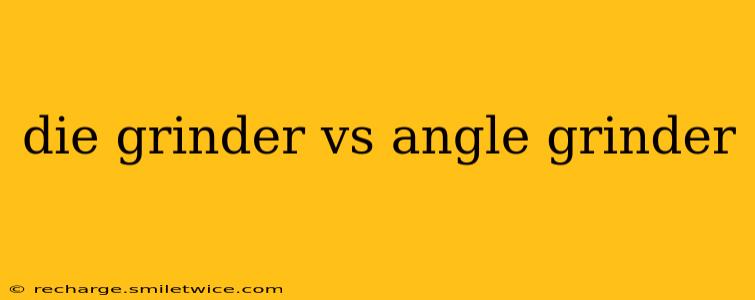Choosing between a die grinder and an angle grinder can feel overwhelming, especially for DIY enthusiasts and professionals alike. Both are powerful rotary tools capable of grinding, polishing, and cutting, but their distinct designs and applications make them ideal for different tasks. This comprehensive guide will dissect the key differences, helping you determine which tool best suits your needs.
What is a Die Grinder?
A die grinder is a compact, high-speed rotary tool typically used for intricate detail work and precision grinding. Its smaller size and pencil-like grip allow for excellent maneuverability in tight spaces. The high RPMs (revolutions per minute) make it exceptionally effective for removing material quickly from small areas. They often come equipped with a variety of collets to accommodate different sized bits, enhancing their versatility.
What is an Angle Grinder?
An angle grinder, also known as a side grinder, is a more robust and powerful tool designed for heavier-duty applications. Its larger size and disc-based design make it perfect for cutting, grinding, and polishing larger surfaces. While less precise than a die grinder, its raw power excels in tasks requiring significant material removal. Angle grinders usually employ a larger disc, typically abrasive, but also available for cutting metal, stone, and other materials.
Die Grinder vs. Angle Grinder: Key Differences
| Feature | Die Grinder | Angle Grinder |
|---|---|---|
| Size & Weight | Smaller, lighter, more compact | Larger, heavier, less maneuverable |
| Power | High RPM, precise, less powerful overall | Lower RPM (relatively), powerful, less precise |
| Applications | Detail work, intricate grinding, polishing | Heavy-duty grinding, cutting, polishing |
| Maneuverability | Excellent | Limited |
| Typical Use | Jewelers, machinists, detail work | Construction workers, metalworkers |
| Disc/Bit Size | Smaller bits and accessories | Larger discs |
What are the different types of die grinders?
Die grinders are categorized primarily by their power source: pneumatic (air-powered), electric (corded or cordless), and even some hydraulic versions exist for specialized applications. The choice depends on the availability of compressed air, the need for cordless mobility, and the power requirements of the job.
What are the different types of angle grinders?
Angle grinders also come in pneumatic, electric (corded and cordless), and even some hydraulic options. Similar to die grinders, the power source selection hinges on the specific application and practical considerations. The size of the angle grinder also varies, offering different power outputs and capacities.
Which is better for cutting metal?
For cutting metal, an angle grinder is generally preferred due to its power and the availability of cutting discs specifically designed for metal. While a die grinder can cut metal with the right accessories, it's not its strength and would be much slower and potentially less precise.
Which is better for grinding welds?
Again, the angle grinder typically wins for grinding welds. Its higher power and larger disc size allow for quicker and more efficient removal of excess weld material. However, for detailed weld cleanup or grinding in tight spaces, a die grinder might be necessary for finishing touches.
Which is better for polishing?
Both tools can polish, but their suitability depends on the surface area. A die grinder with appropriate polishing attachments excels in polishing small, intricate parts or hard-to-reach areas. For larger surfaces, an angle grinder with a polishing disc will be more efficient.
Which is safer to use?
Both tools pose safety risks if not used correctly. Safety precautions, including proper eye and ear protection, are crucial regardless of the tool. However, the greater power and potential for kickback of an angle grinder make it generally more hazardous. Proper training and adherence to safety guidelines are paramount for both.
Ultimately, the best choice between a die grinder and an angle grinder depends entirely on the specific task at hand. Consider the size of the project, the level of detail required, and the material being worked with to make an informed decision. If you anticipate needing both types of work, investing in both tools is a worthwhile investment for a comprehensive workshop setup.
